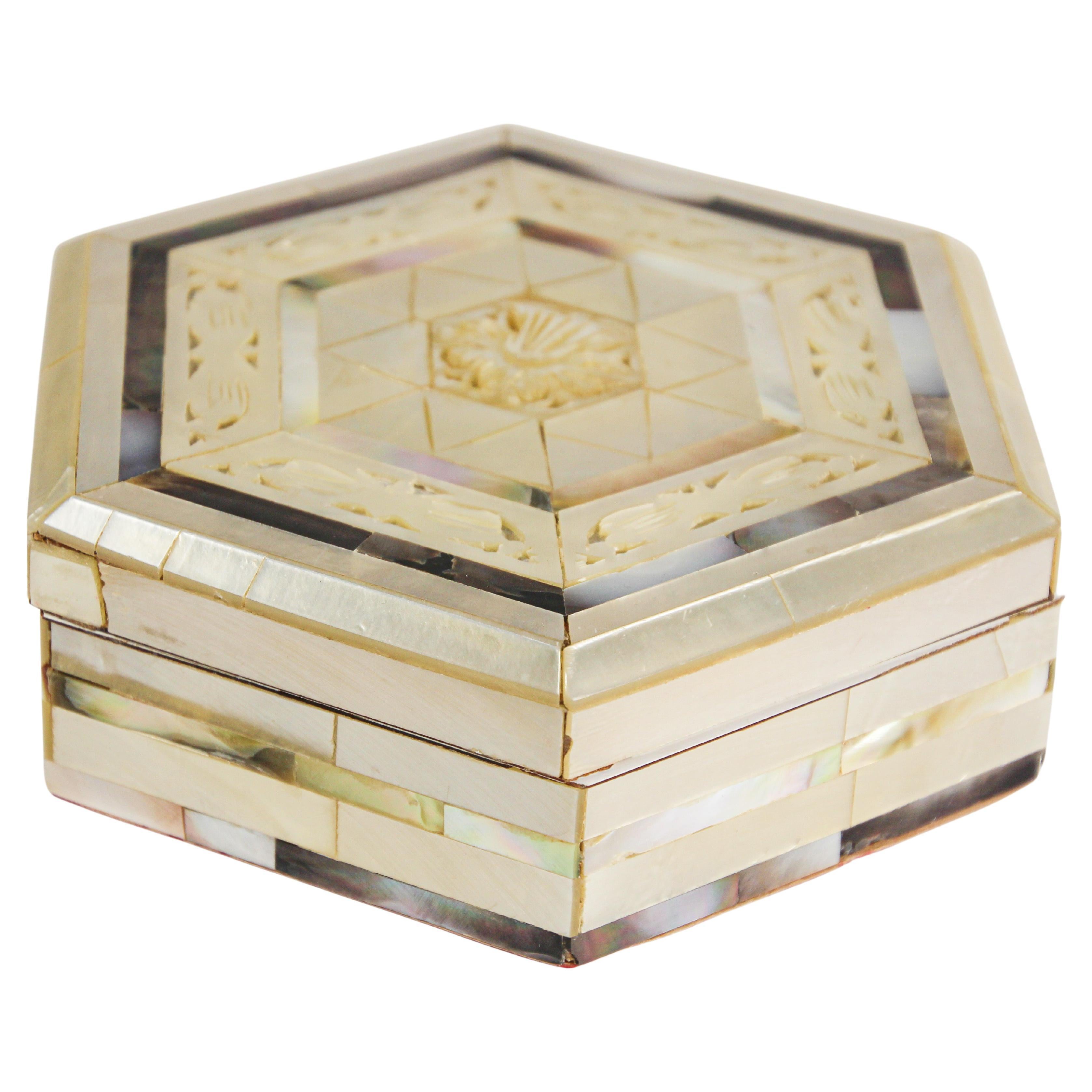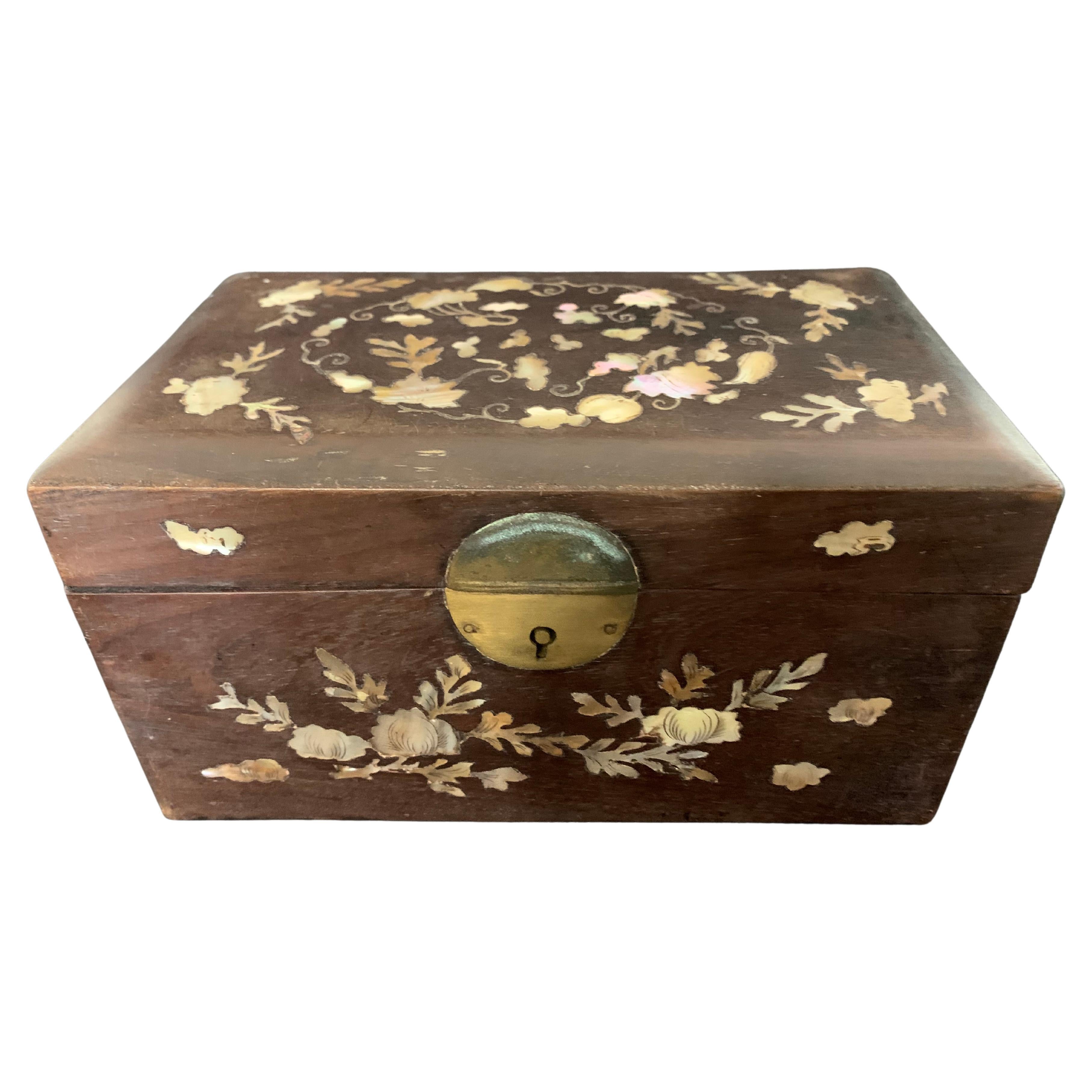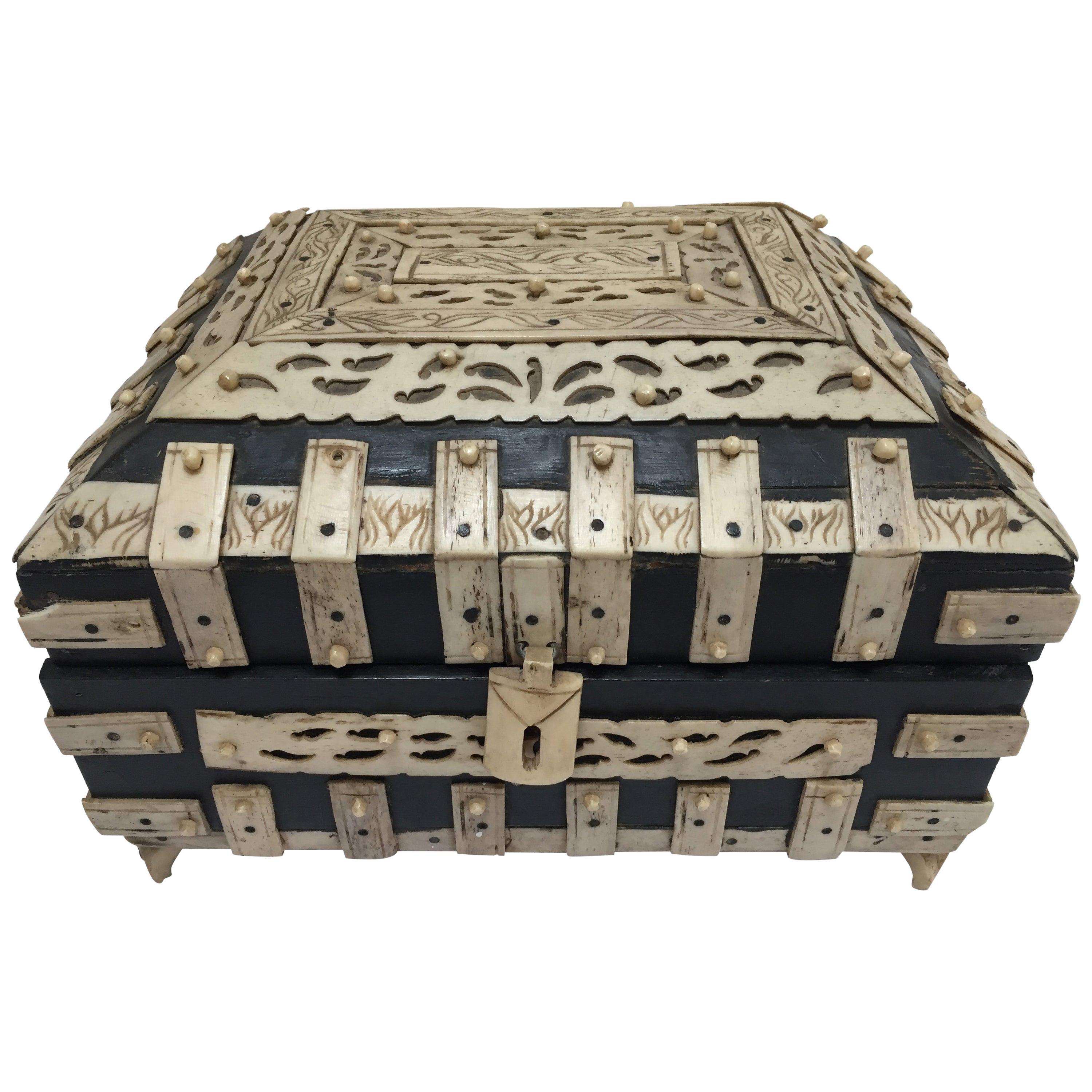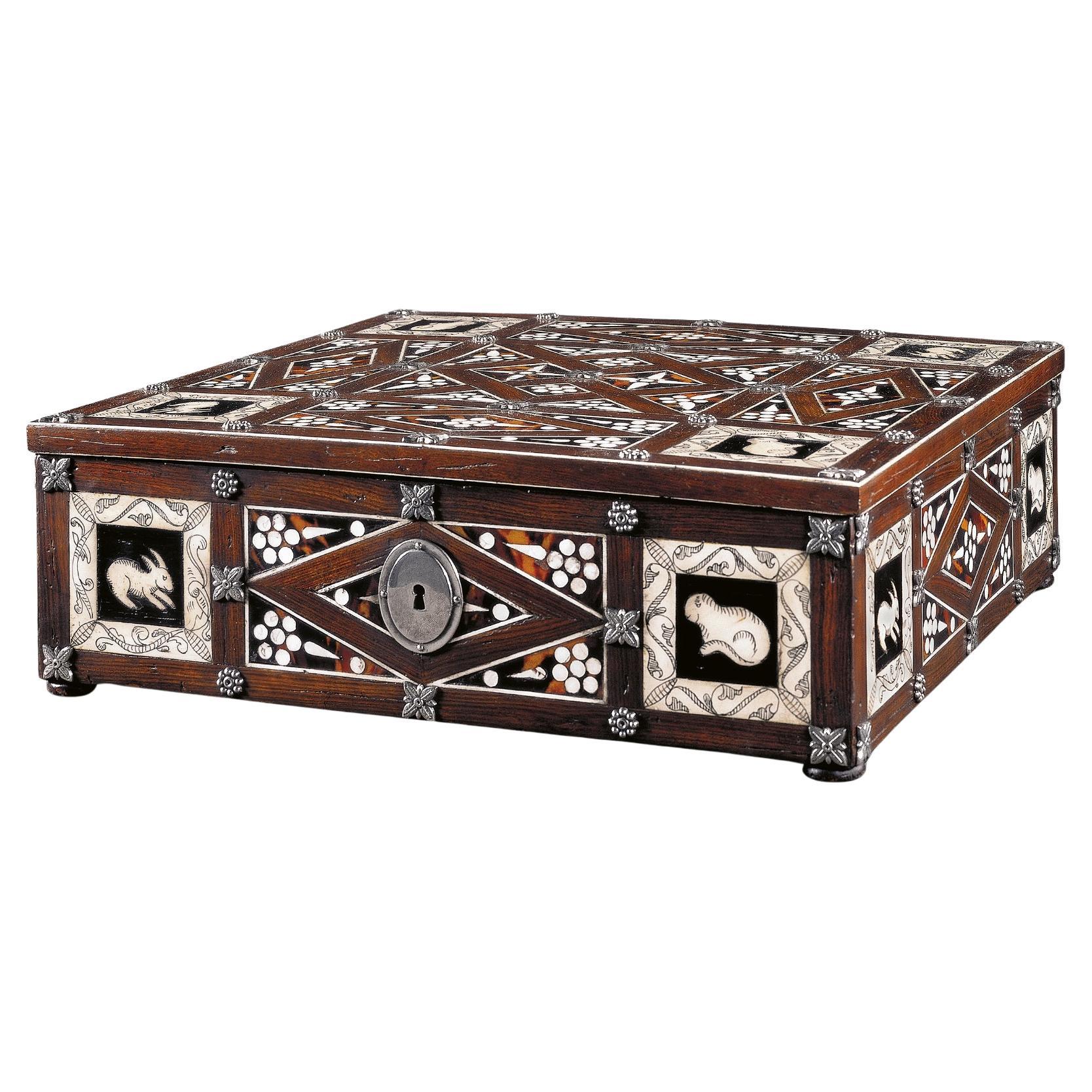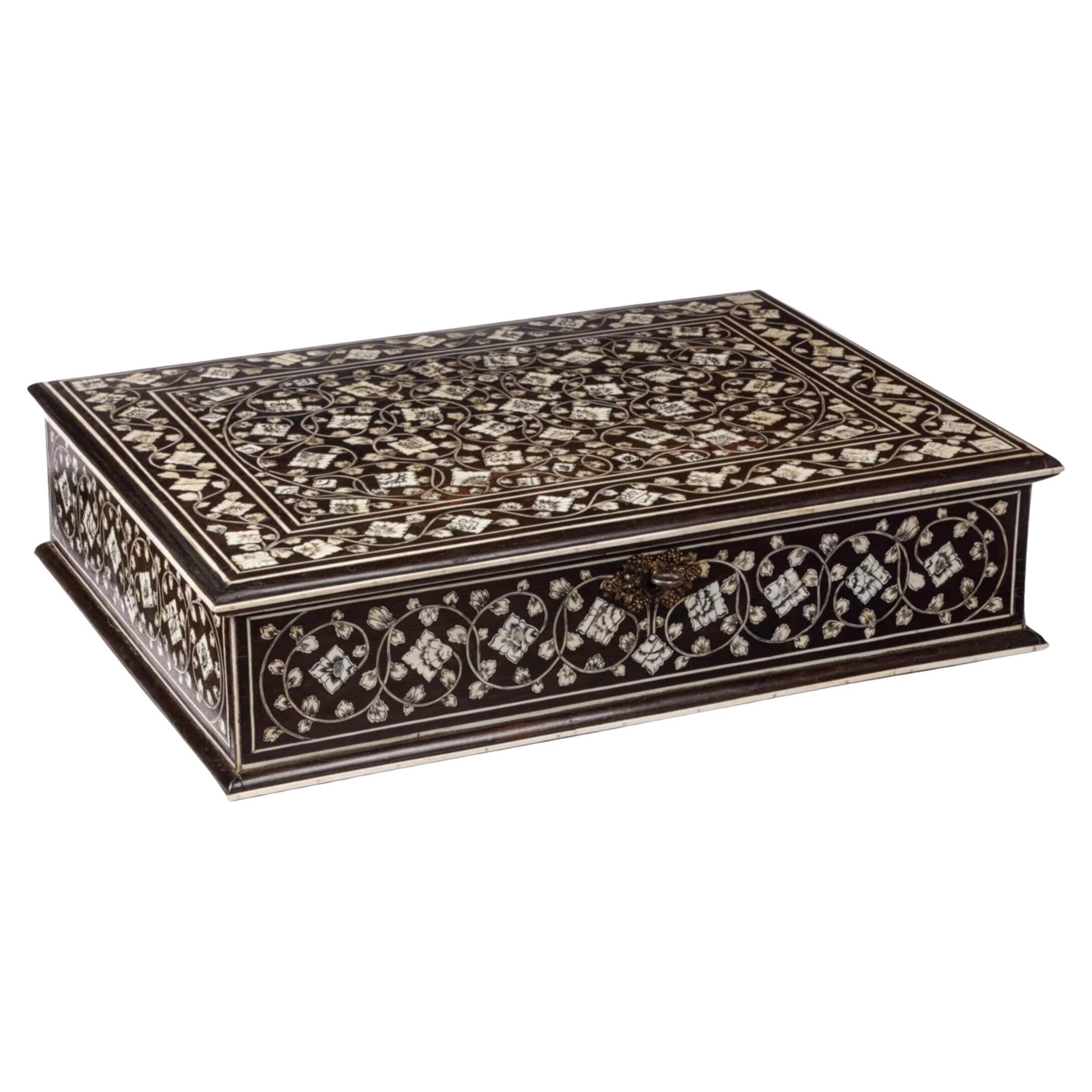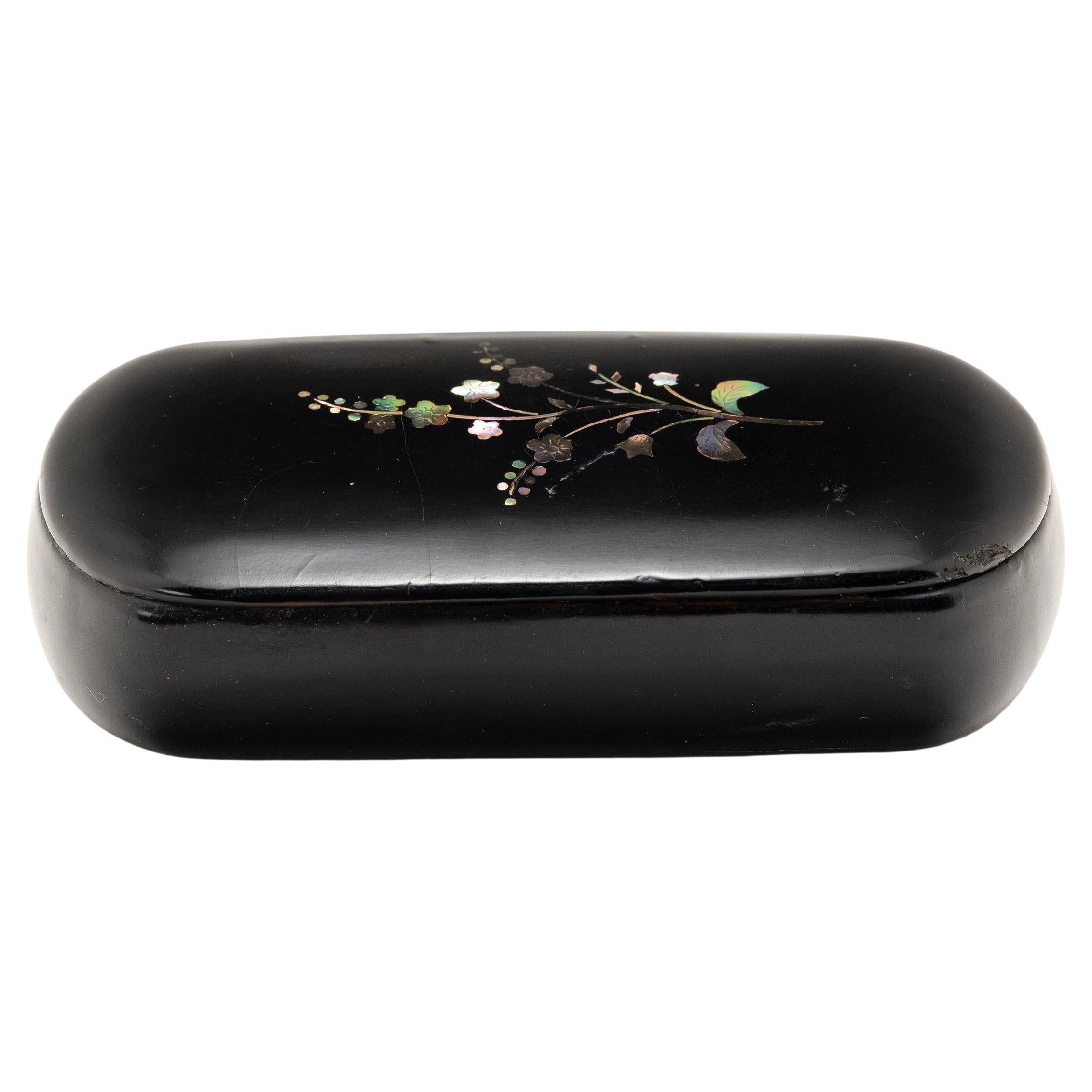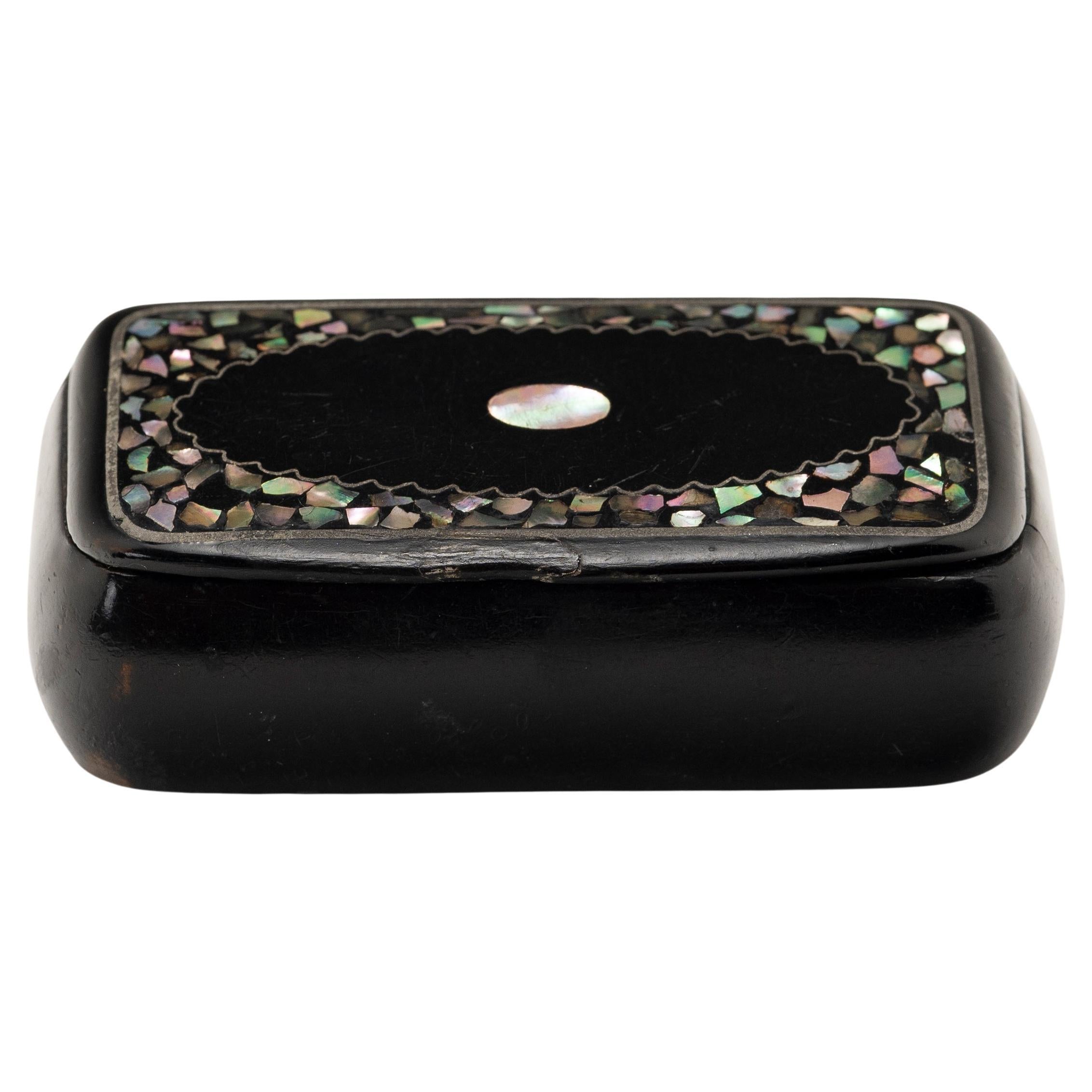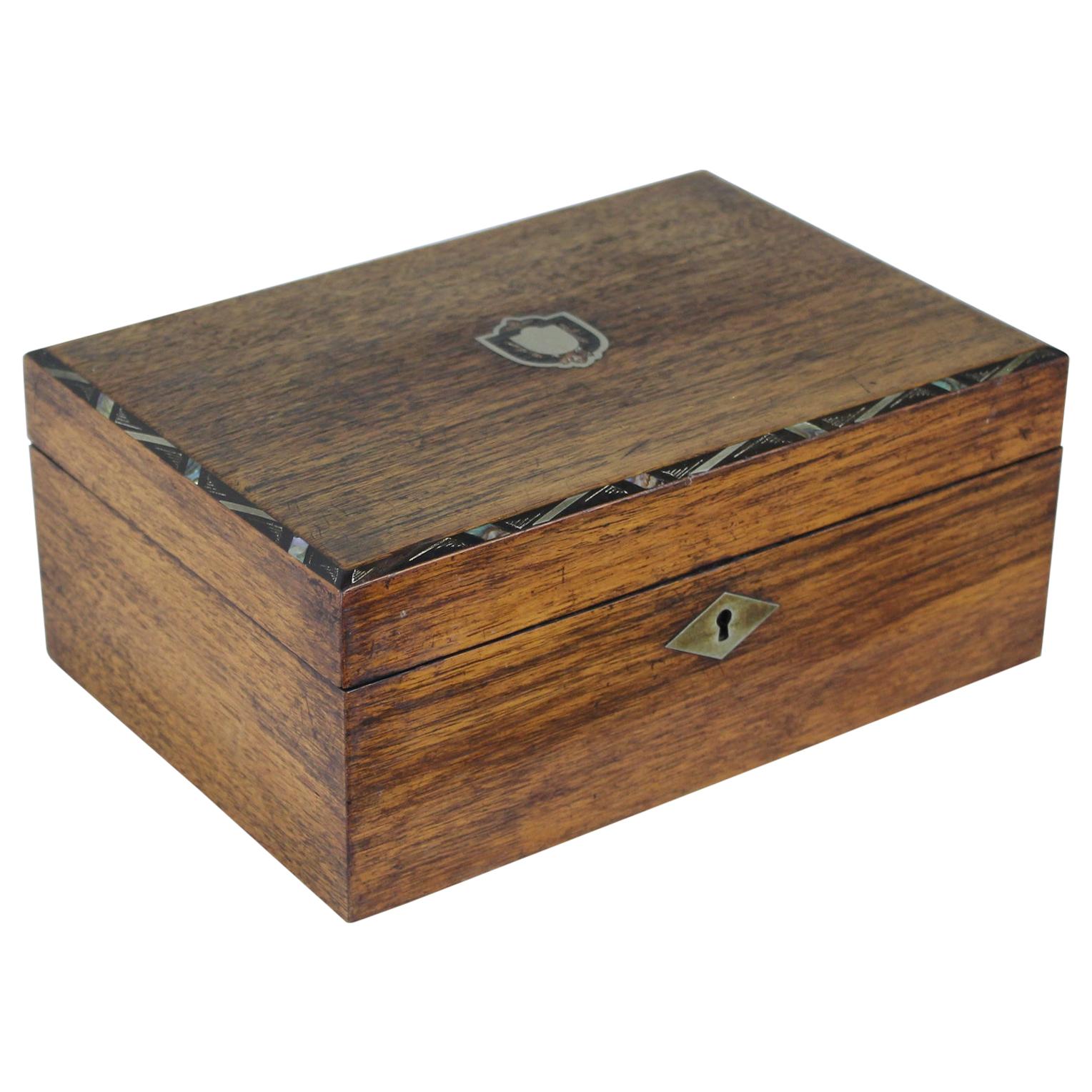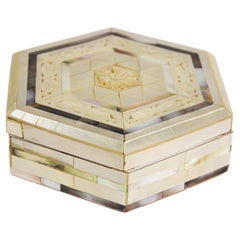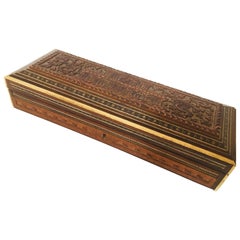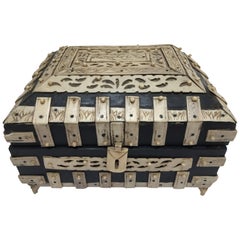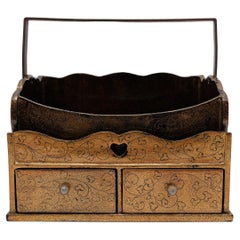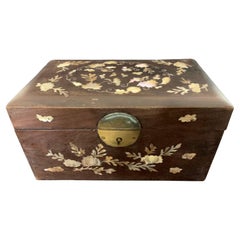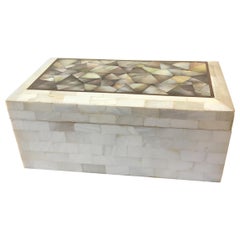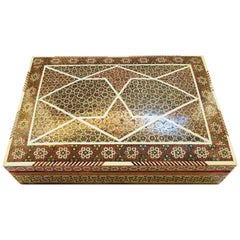
Syrian Mother-of-Pearl Bone Inlay Box
View Similar Items
Want more images or videos?
Request additional images or videos from the seller
1 of 9
Syrian Mother-of-Pearl Bone Inlay Box
About the Item
- Dimensions:Height: 3.5 in (8.89 cm)Width: 12.5 in (31.75 cm)Depth: 8.75 in (22.23 cm)
- Style:Islamic (In the Style Of)
- Materials and Techniques:
- Place of Origin:
- Period:
- Date of Manufacture:1950
- Condition:Wear consistent with age and use.
- Seller Location:North Hollywood, CA
- Reference Number:Seller: BSY181stDibs: LU906811139591
About the Seller
5.0
Platinum Seller
These expertly vetted sellers are 1stDibs' most experienced sellers and are rated highest by our customers.
1stDibs seller since 2011
2,649 sales on 1stDibs
Typical response time: 1 hour
More From This SellerView All
- Handcrafted White Mother of Pearl Inlaid Moorish Octagonal BoxLocated in North Hollywood, CAExquisite handcrafted white mother of pearl inlaid and hand carved lidded box. Small octagonal Anglo Indian decorative box intricately decorated with Moorish motif designs which hav...Category
Mid-20th Century Indian Moorish Decorative Boxes
MaterialsShell, Fruitwood, Abalone, Mother-of-Pearl
- Fine Antique Anglo Indian Bombay Inlay BoxBy RajhastaniLocated in North Hollywood, CAFine antique Anglo-Indian hand carved wooden jewelry box inlaid. Nice Indian Mughal pen box handcrafted in very fine Sadeli micro mosaic...Category
Antique Late 19th Century Indian Islamic Decorative Boxes
MaterialsWood
- Anglo-Indian Vizagapatam Bombay Mughal Style Footed Box With Bone OverlayLocated in North Hollywood, CANice and unusual Indian Mughal style large decorative box, filigree and carved horn. Anglo-Indian footed domed box with exceptional engraved details throughout with filigree and carved veneered bone plaques with arabesque carving. Vizagapatam, late 19th century. History of the Anglo-Indian Boxes Beginning in the early part of the 18th century, Indian artisans made what came to be known as Anglo-Indian boxes for the English residents living in India, who eventually brought or sent them back to England. At the beginning of the 19th century, India began exporting these boxes commercially, although not in any significant numbers until the 1850s. People valued them so highly that manufacturers of tins copied the designs on them in the late 19th and early 20th century. Anglo-Indian boxes fall into four groups: Rosewood or ebony boxes inlaid; sandalwood boxes veneered; sandalwood boxes covered with Sadeli mosaic; and carved boxes often combined with Sadeli mosaic/ The first two categories came from Vizagapatam in East India while the last two came from Bombay in West India. English traders discovered the rich woods and intricate workmanship of Indian artisans, so colonial government officials began to recognize the work of the Indian artists and craftsmen as a source for satisfying the need for furniture and boxes, which would both serve to enhance English households in India. This gave rise to the cabinetmaking workshops in Vizagapatam between Calcutta and Madras. Craftsmen made the first boxes to be decorated with Sadeli mosaic of rosewood or ebony, incised to give further definition to the decoration, directly inlaid into the wood. The shape of the early boxes was either sloping at the front with a flatter section at the back, reminiscent of English writing slopes, or rectangular. Artisans inlaid the borders with stylized floral scrolls and the centers with a single floral motif following a circular or oval symmetrical or asymmetrical pattern. The edging was ornamental and protective, both helped protect the end grain against the weather. Made in Vizagapatam, situated on the south east coast of India, near Madras These exotic boxes...Category
Antique Late 19th Century Indian Anglo Raj Decorative Boxes
MaterialsWood
- Middle Eastern Syrian Inlay Jewelry BoxLocated in North Hollywood, CAExquisite Middle Eastern Syrian inlay jewelry box intricately inlaid with Moorish motif designs which have been painstakingly inlaid micro mosaic marque...Category
Early 20th Century Moorish Jewelry Boxes
MaterialsFruitwood
- Vintage Moorish Box Mosaic MarquetryLocated in North Hollywood, CAExquisite handcrafted Middle Eastern Lebanese mosaic marquetry wood box. Small octagonal walnut Syrian style box intricately decorated with Moorish...Category
Mid-20th Century Lebanese Moorish Decorative Boxes
MaterialsAbalone, Mother-of-Pearl, Shell, Fruitwood
- Middle Eastern Mosaic Moorish Box InlaidLocated in North Hollywood, CAExquisite handcrafted Middle Eastern Lebanese, Egyptian mosaic marquetry wood box inlaid. Small vintage walnut Syrian style box intricately decorated with Moorish motif designs which have been painstakingly inlaid with mosaic shell and marquetry. Great craftsmanship handmade by artisans in the Middle East, Lebanon or Egypt. Dimensions Height: 2.25 in. Width: 6 in. Depth: 4 in. Circa 1950. Great Middle Eastern Islamic Mosaic...Category
Mid-20th Century Lebanese Moorish Decorative Boxes
MaterialsAbalone, Fruitwood, Shell
You May Also Like
- Japanese Gilt Tabako-Bon with Mother-of-Pearl InlayLocated in Chicago, ILThis handled box is a Japanese tabako-bon, or 'tobacco tray,' used to store tobacco and smoking accessories. Believed to have evolved from the traditional...Category
Mid-20th Century Japanese Decorative Boxes
MaterialsMother-of-Pearl, Wood
- Indochinese Box in Wood and Mother of Pearl circa 1900Located in Beuzevillette, FRNice wooden and mother-of-pearl box from the 1900s. The mother-of-pearl inlays form plant motifs (flowers and foliage), incised to give volume to the different parts. It closes with ...Category
Antique Late 19th Century Asian Decorative Boxes
MaterialsWood
- Mother of Pearl and Bone BoxLocated in Tarrytown, NYMother of pearl and bone box.Category
Early 2000s Decorative Boxes
MaterialsMother-of-Pearl
- 16th-Century Indo-Portuguese Colonial Mother-of-pearl Gujarat CasketLocated in Amsterdam, NLAn exceptional Indo-Portuguese colonial mother-of-pearl veneered casket with silver mounts India, Gujarat, 2nd half of the 16th century, the silver mounts Goa or probably Lisbon Measures: H. 16 x W. 24.6 x D. 16.1 cm An exceptional Gujarati casket with a rectangular box and truncated pyramidal lid (with slopes on each side and a flat top) made from exotic wood, probably teak (Tectona grandis), covered with a mother-of-pearl mosaic. The tesserae, cut from the shell of the green turban sea snail (Turbo marmoratus, a marine gastropod) in the shape of fish scales, are pinned to the wooden structure with silver ball-headed nails. The casket is set on bracket feet on the corners. The masterfully engraved decoration of the silver mounts follows the most refined and erudite Mannerist repertoire of rinceaux and ferroneries dating from the mid-16th century. The high quality and refinement of the silver mounts and, likewise, the silver nails that replaced the original brass pins used to hold the mother-of-pearl tesserae in place indicate the work of a silversmith probably working in Lisbon in the second half of the 16th century. The Indian origin of this production, namely from Cambay (Khambhat) and Surat in the present state of Gujarat in north India, is, as for the last three decades, consensual and fully demonstrated, not only by documentary and literary evidence - such as descriptions, travelogues and contemporary archival documentation - but also by the survival in situ of 16th-century wooden structures covered in mother-of-pearl tesserae. A fine example is a canopy decorating the tomb (dargah) of the Sufi saint, Sheik Salim Chisti (1478-1572) in Fatehpur Sikri in Agra district in the state of Uttar Pradesh, north India. This is an artistic production, geometric in character and Islamic in nature, where usually the mother-of-pearl tesserae form complex designs of fish scales or, similar to the dishes also made using the same technique, with the thin brass sheets and pins, stylized lotus flowers. The truncated pyramidal shape corresponds, like their contemporary tortoiseshell counterparts also made in Gujarat, to a piece of furniture used in the Indian subcontinent within the Islamic world prior to the arrival of the first Portuguese. This shape, in fact, is very old and peculiar to East-Asian caskets, chests or boxes used to contain and protect Buddhist texts, the sutras. A similar chest is the famous and large reliquary chest from Lisbon cathedral that once contained the relics of the city's patron saint, Saint Vincent. Both match in shape, having the same kind of socle or pedestal and bracket feet, and in their engraved silver mountings, featuring the same type of refined, erudite decoration. Their differences lie in the silver borders that frame the entire length of the edges of the chest (both the box and the lid), pinned with silver nails, and on the lock plate, shaped like a coat of arms in the Lisbon example. Given the exceptional dimensions of the reliquary casket...Category
Antique 16th Century Indian Jewelry Boxes
MaterialsSilver
- Taraceada Box with Rabbits, with Inlays, Mother Pearl, Bone, Faux TotrtoiseshellBy Alfonso MarinaLocated in Bosques de las Lomas, MXVery beautiful and detailed decorative box. Each part that conforms this piece is a jewel by itself: brass inlays, mother pearl, sgraffito bone and faux tortoiseshell.Category
21st Century and Contemporary Mexican Decorative Boxes
MaterialsCedar
- 18th century Dutch-Colonial ‘Vizagapatam’ pen-engraved bone inlaid ebony boxLocated in Amsterdam, NLA large Indian Colonial ‘Vizagapatam’ pen-engraved bone inlaid ebony box Masulipatnam or Vizagapatam, 2nd half 18th century H. 10.8 x W. 47 x D. 34 cm ...Category
Antique Late 18th Century Indian Dutch Colonial More Asian Art, Objects ...
MaterialsBone, Ebony
Recently Viewed
View AllMore Ways To Browse
Syrian Bone Inlay
Doris Duke
Retro Wooden Jewelry Box
Syrian Box
Vintage Duke Box
Mother Of Pearl And Wooden Box
Wooden Box Marquetry
Micro Mosaic Inlay
Syrian Inlaid Box
Wood And Bone Jewelry
Moorish Diamonds
Retro Duke Box
Marquetry Artwork
Islamic Inlaid Boxes
Vintage Inlaid Wooden Box
Moorish Mother Of Pearl Box
Islamic Marquetry
Syria Jewelry

